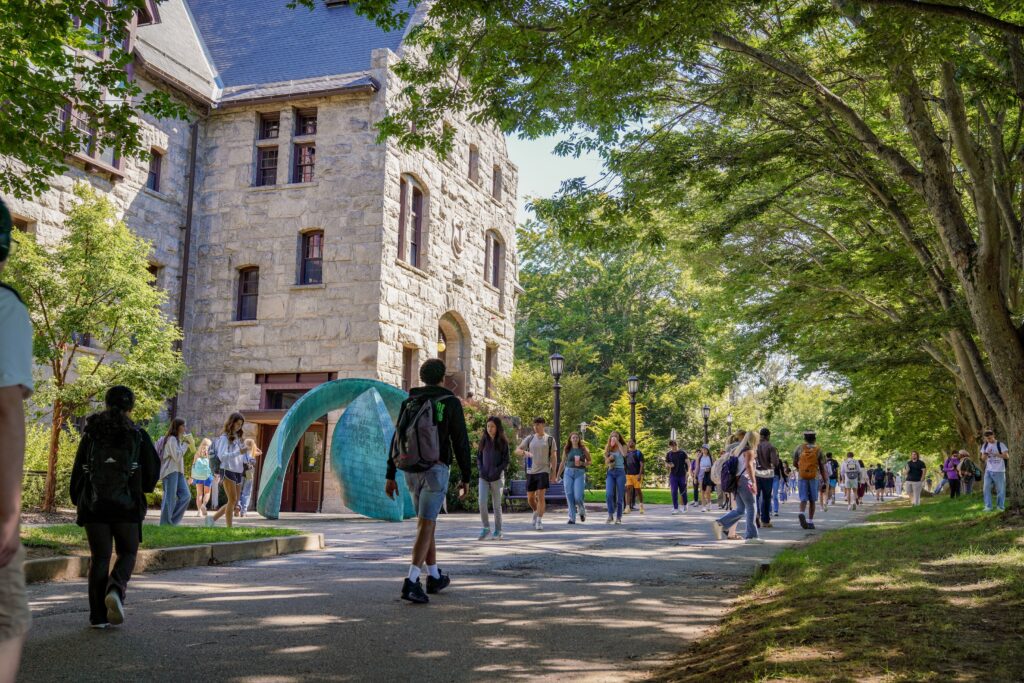Students walk past Lippitt Hall on the University of Rhode Island’s Kingston campus. (Catherine Scott/URI photo)
Despite the problem-plagued rollout of the updated federal student aid application and continued competition from free tuition programs, preliminary enrollment numbers show a modest increase in students attending the University of Rhode Island.
That’s according to data reviewed Monday by the university’s Board of Trustees’ Academic Affairs and Research Committee. Complete enrollment data will be available Oct. 15.
The university received 26,983 first-year applications as of Sept. 5, which is a year-over-year increase of 1,500 students. As of Sept. 16, there were over 650 grad student applications, Dean Libutti, associate vice president for enrollment management and student success, told trustees.
Libutti said he anticipates overall enrollment to be around 17,000 inclusive of all students. In this year’s pool of enrollees, about a third identify as the first in their family to attend college. Learners from 65 countries and 47 states are represented.
“If anyone would like to help us in Montana, North Dakota and South Dakota, we’ll be at 50,” Libutti said.
One concern carried over from the committee’s last meeting of the previous academic year: The delayed release schedule of the Free Application for Federal Student Aid (FAFSA), which led to admissions departments receiving the data they needed to make financial aid and acceptance decisions well after the usual deadlines.
“That certainly had an impact on us, especially in that out-of-state recruitment phase,” Libutti said. “I would have loved to see our FAFSA completion rates for our applicant pool 70 to 75%. When I looked this morning, it was still in the 65% range.”
Another perennial worry is the competitive edge gained by Rhode Island’s other two public institutions of higher learning — the Community College of Rhode Island (CCRI) and Rhode Island College (RIC), each of which have state-funded scholarship programs. Students sometimes choose to attend these schools for affordability reasons, rather than attend URI which continues to lack a state-subsidized scholarship program despite repeated rallying at the State House.
If anyone would like to help us in Montana, North Dakota and South Dakota, we’ll be at 50.
– Dean Libutti, URI associate vice president for enrollment management and student success
“We lose over 400 students a year who we admitted to the other two schools, and many of them change their majors away from STEM and engineering and life sciences to go to free [college],” Libutti said. “And that really is not going to help the university and the state with enhancing earnings potential and leading workforce development.”
But in-state students are the minority at URI. In fall 2023, out-of-state students comprised 51.5% of URI enrollment.
Libutti cited New York as an example where reduced tuition programs are helping state schools increase applications. The statewide Excelsior Scholarship, crafted by then-Gov. Andrew Cuomo in 2017, allows students to attend state schools tuition-free if their families make under $125,000 in annual income. At the end of the 2021-2022 academic year, around 73,000 students had attended college on an Excelsior Scholarship since its inception, CNBC reported.
The State University of New York additionally offers prospective students tuition comparable to their home state’s flagship university. The program is open to students in Connecticut, Pennsylvania, New Jersey, Massachusetts, Vermont, New Hampshire, Illinois and California.
“State free [and] reduced tuition programs are really changing the game of enrollment right now,” Libutti told the trustees. “The reality here is you’re starting to see students moving to these programs based on this kind of support.”
Neil Kerwin, the committee’s chair, wondered if students who take advantage of subsidized scholarships might return to URI, as students enrolled in CCRI’s Promise Scholarship program can attend URI after they complete their studies at the community college. URI has maintained strong and positive relationships with CCRI, Libutti said, including relative ease in transferring credits between the two institutions.
But many students don’t continue on to four-year programs, Libutti said.
“We had hoped to have a much stronger pipeline coming from the community college to the university,” Libutti said. “The reality is their graduation rates…The challenge with these programs is they very rarely are a strong pipeline because of the completion rates.”
Libutti suggested tweaking perceptions to prioritize quality over value might help URI.
“One of the challenges out there with all these free programs is to show the value in why we should attend, yield-wise, rather than the concept of free,” he said.
URI scored highest among New England’s public universities
Some evidence that URI is worth the price tag: A new ranking from the Wall Street Journal which saw Rhode Island’s flagship score highest among public universities in New England.
Of the 500 universities in the WSJ/College Pulse 2025 Best Colleges list, URI scored 84th place overall, which was 15 spots higher than the University of Connecticut, the only other public university in New England to make the top 100. URI also placed 35th among public universities nationwide. The report’s methodology incorporates student outcomes like eventual salaries and tuition debt, as well as the school’s learning environment and diversity.
“This report certainly is a great example of showing that value proposition,” Libutti said. “I can assure you we will be singing it from the rooftops of Kingston to Texas and beyond.”
Kerwin replied: “You gotta take it to Montana and the Dakotas now, right?”
The first full Board of Trustees of the new academic year is scheduled to meet Sept. 27. The Academic Affairs Committee is set to meet again on Oct. 22, when Libutti will present updated enrollment numbers.
GET THE MORNING HEADLINES DELIVERED TO YOUR INBOX

